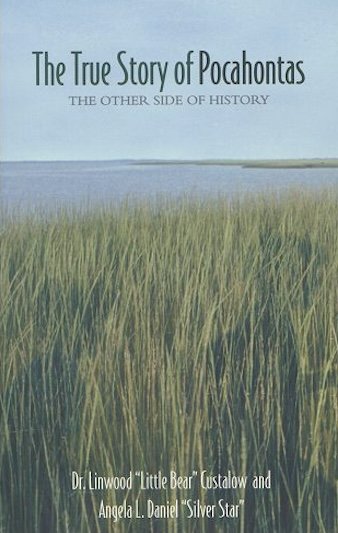Pocahontas’ real name was Matoaka (Mat-oh-ah-ka). She was the daughter of Wahunsenaca (Wah-hoon-sen’-ah-ca), the leader of a nation of indigenous Virginia tribes that the English came to call the Powhatan (Pow’-ah-tan) Confederacy or Powhatan Chieftainship.
Matoaka is believed to have been 10 or 11 in 1607 when the Virginia Company colonists established Jamestown. Her mother’s tribe was the Mattaponi (Mat-ah-pō-nī’). The Mattaponi Oral History recorded that Matoaka’s mother, Pocahontas, died in childbirth. That is why her people referred to her as Pocahontas, the name the English would make famous. According to the Oral History it means “Laughing and Joyous One.” It was most often translated by non-Native writers as “mischief,” “Little mischief,” and “little playful one.”
The legend of Pocahontas claims that she saved an early colonial leader, John Smith, from execution because she instantly fell in love with him, and that she convinced her father to provide the colonists of Jamestown with food. Even with scarce historical sources, it is easy to see through such a fairytale. No child in any society would have wielded such influence over such a crucial decision. Europeans were not unknown to the Powhatan. Wahunsenaca offered the English colonists membership in the Powhatan Nation in order to access their weapons and contain their spread throughout his country.
Matoaka frequently visited Jamestown along with the Powhatan delegations that brought food and other trade goods to Jamestown. Several primary sources recorded her as an outgoing child who was fond of playing with the English children she met there. John Smith wrote that he learned many Algonquian words from her and shared English ones in return. Smith continued as the colony’s representative in military and trade matters with the Native population for its first 2 years, but he had many enemies in Jamestown and struggled to maintain authority. After suffering serious burns in a gunpowder accident in 1609, he returned to England for treatment, never to see Virginia again. His fellow colonists told Wahunsenaca that Smith was dead.
From this point on, relations between the English and the Powhatan deteriorated. Although Smith had repeatedly acted outside of his agreements with Wahunsenaca by raiding for more food than the Powhatan had gifted, he had also tried to limit these excesses to maintain the alliance as long as he could. After he departed, the English colonists and his diplomatic successors tried to take a harder line with their hosts. Raids increased and fertile land along the river banks was taken by force. As a result, Wahunsenaca put an end to the gifts of food and attempted to starve the English out by moving Powhatan villages further inland. He sent word that the colonists should leave his country or confine themselves to Jamestown. He would no longer guarantee their safety beyond the fort.
The colonists of Jamestown experienced many struggles over the following years, but Matoaka did not reappear until she was kidnapped by Captain Samuel Argall in 1612. The Mattaponi Oral History recorded that before this she had married a Patawomeck (pat-ah-ow-mek) warrior named Kakoum and had a son. She was living with her family in a Patawomeck village when Argall found her. The colony’s governing council used her as leverage against Wahunsenaca to secure food, land, and stave off any direct attacks on their growing settlements.
In 1614 Matoaka converted to Christianity, was renamed Rebecca, and married the colony’s secretary, a tobacco planter named John Rolfe. She gave birth to a son named Thomas soon after. In 1616, the Virginia Company brought Matoaka, her family, Captain Argall, and the colony’s governor to London in order to promote the venture and secure more investment. Matoaka’s sister, Mattachana, also accompanied her. It was Mattachanna’s testimony after her return from England that informed the Mattaponi Oral History about what happened there. Matoaka spent a year in England where she learned more about the English and their intentions in her country. In the spring of 1617 the party set sail to return to Virginia, but Matoaka became sick before they reached the sea. She died and was buried in Gravesend, England.
Some European and American histories claim she fell ill days before setting sail, and others only after boarding the ship. The Mattaponi Oral History recorded that she only became sick after dining with her husband and Captain Argall on the ship, and that she told her sister that she believed “the English” had put something in her food.
In the following weeks I will explore these stories and sources in more detail. Why would Matoaka consent to marry an Englishman after being kidnapped? Was Wahunsenaca unwilling to attack Jamestown for fear of her safety, the English guns, or some other reason? Why would the Virginia Company want to murder Matoaka after having used her so successfully to wring concessions from her father and to present the image of a successful colonial project to the English public, royalty, and prospective investors?
There are no easy answers to any of these questions. I will explore them through several primary and secondary sources. The Mattaponi Oral History regarding Matoaka, published for the first time in 2007 as “The True Story of Pocahontas” is an invaluable resource that previous generations had no access to. It adds a much needed perspective from Matoaka’s own people to a story that has been told and retold by European and American authors with little or no regard for the woman behind the myth.
Sources:
The True Story of Pocahontas: The Other Side of History, From the Sacred History of the Mattaponi Reservation People.
Dr. Linwood “Little Bear” Custalow and Angela L. Daniel “Silver Star.” Fulcrum Publishing: Golden, Colorado, 2007.
Video interview with Angela L. Daniel and Linwood Custalow- Book TV, C-Span
Book Review- The One Feather

